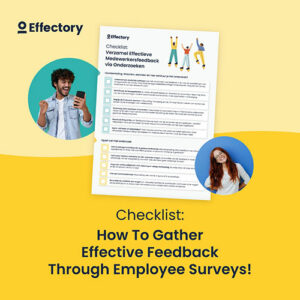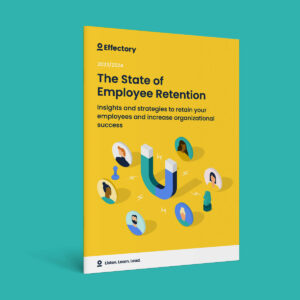Organisational commitment is the bond employees experience with their organisation. Broadly speaking, employees who are committed to their organisation generally feel a connection with their organisation, feel that they fit in and, feel they understand the goals of the organisation. The added value of such employees is that they tend to be more determined in their work, show relatively high productivity and are more proactive in offering their support.
How to increase employee commitment

Why is employee commitment important
Committed employees bring added value to the organisation through their determination, proactive support, relatively high productivity and awareness of quality. They are also less likely to call in sick. Committed employees display positive behaviour within organisations, are more likely to positively refer the company to contacts and are further more likely to adopt the organisation’s vision and goals (both professionally and personally).
Alongside this, committed employees are much less likely to leave their current position. In light of the increasing competitive nature of organisations, employee commitment is increasingly playing a key part in retaining top talent.
How to gather feedback from your employees
The definitive checklist for creating your employee engagement survey.
DownloadHow to increase employee commitment
Using data collected from our employee surveys and correlation analysis, Effectory is able to the discover the extent to which factors influence employee commitment. Our research has uncovered four factors have been proven to have the biggest influence on employee commitment levels. The influencers include: clear company goals, gaining energy from work, feeling a fit with the company and a challenging work environment.
In order to help you get to work on increasing employee commitment, the following section discusses the four influencers, why they are important and includes best practices. Simply by addressing one of the following four areas, organisations are able to positively impact employees’ commitment.
3 Key Types of Organisational Commitment
#1 Clear company objectives
Clarity about intended goals helps employees make better day-to-day decisions at work. Employees know what the collective objective is and they can adapt their own contribution to it accordingly. Knowing the companies objectives helps employees cooperate more efficiently with one another and further, reduces the time and resources wasted on issues that do not have any bearing on the big picture.
How can you create clear company goals?
- Think about what your organisation’s positive contribution to society may be and include this in the formulation of the organisational goal. Including the how your company benefits society helps make goals more appealing to employees.
- Ensure top management are clear on what the goals are and that they regularly communicate these both internally and externally. In general the simpler the goal is, the easier it is to communicate, roll out and strive towards.
- Allow each section/each team to interpret the organisational goals to form their own goals. This will make everything more specific and enables the goals to be aligned to one another.
- Communicate regularly about any progress and whether or not your organisational goals are being reached. Doing so keeps the process of reaching goals more vibrant, and also helps in motivating employees.
Employee engagement and commitment by industry
Employee experience in 3 easy steps
Learn the best ways to improve the employee experience in your organization with these 3 easy-to-follow tips! Get your copy today!
Download: employee experience tips#2 Gaining energy from work
Employees who gain energy from their work feel good about themselves and enjoy doing their work. Apart from the positive effect on the individual employee, organisations benefit when employees gain energy from their work. Employees who gain energy from their work are generally more productive, work better with colleagues and are more willing to develop.
How can you help employees gain energy from their work?
- Ensure a good match between employees and their work. If there turns out to be a mismatch, assistance and/or training should be offered to bridge the gap. In the case of long-term mismatches, every effort should be made to help employees find more suitable work (either inside or outside of the organisation).
- Pay attention to employees’ development. Stagnant jobs with limited challenges will diminish the energy employees get from their work. It is therefore vital that employees’ jobs evolve, for instance by broadening the scope of work.
- Discuss the biggest frustrations that employees encounter at work and challenge them to come up with solutions. Frustrations consume energy, and once removed, both employee satisfaction and energy increase.
- Make sure the workplace atmosphere is good. Agree clearly how you wish to treat each other and invest in team building (i.e. a day out, a lunch together, joint training course etc.).
For some time now our team has, at the end of each day, written down how they felt about their energy levels (did they have a lot of energy left, or little to no energy left) and what they had done that day. After two weeks everyone had a good picture of what personally gave them energy and what consumed their energy. Now when we are allocating duties, we take this into account.
#3 Fitting in
When employees feel like they fit in well with an organisation, they feel a bond and commitment to their organisation. If employees feel at home, they put a greater effort into the organisation and tend to remain with the organisation for a longer period of time.
How can you help employees feeling of fitting in?
- Make sure that employees are clear about the corporate identity. Employees only know if they feel at home if they know what the organisation stands for (mission/vision) and what is important to the organisation (standards/values).
- Create shared experiences among employees, as they reinforce a feeling of belonging and fitting in. Some of the most effective activities are personal meetings, as well as company-wide events.
- Involve employees in company-wide decisions. This helps to ensure support of the decisions, as well as clarity about employees’ thoughts and feelings.
- Consider encouraging management to show their commitment to their employees. By showing a regular interest and genuine appreciation, employees are more likely to feel they fit in.
The State of Employee Retention
Uncover why employees leave, hidden costs to organizations, and proven retention strategies in our insightful report.
Download#4 Challenging work environment
In general, employees need variety and a challenge at work. When an employee feels challenged in his or her job their intrinsic motivation, joy at work and sense of achievement all increase. Overall, employees that are challenged tend to perform better and as a result, are more inclined to stay with their organisation.
At Red Bull, employees are encouraged to come up with ideas themselves. These may be internally or externally focused ideas. If an idea is a good one the employee concerned is given (alone or with others) the freedom to really develop it and put it into practice. Doing so gives employees a great sense of responsibility and they also become the owner of their own promotion or event.
How can you create a challenging work environment?
- Give regular feedback. Constructive feedback about improvement opportunities can bring about a lot of challenges, although don’t forget the positives!
- Discuss explicitly in the appraisal and or performance interviews whether the work is still challenging enough. In addition, discuss what makes the work challenging for someone and how best to keep it that way.
- Ensure that once in a while, employees get to look at other areas of the organisation/departments. Often jobs which remain undone in one department might be seen as a welcome challenge to another.
Book a free demo. See our solutions in action.
Effectory is Europe’s Leading provider of Employee Listening Solutions. Schedule a product demo and discover how to enhance your employees’ engagement.
Demo request


